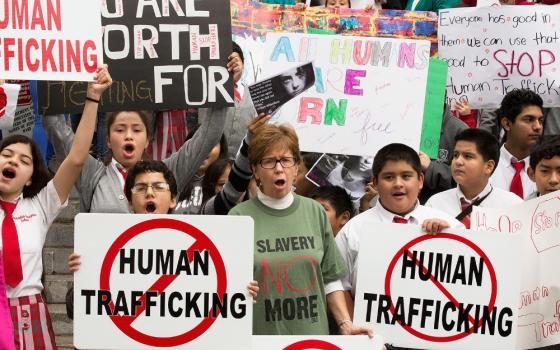“What a steep learning curve!” we often hear people say as they find themselves in a new job, ministry or unfamiliar situation. It’s challenging to discover what is happening, understand a different culture or perspective, consider how to approach situations and chart new ways forward.
That’s where we are when it comes to human trafficking: on a steep learning curve. There’s a whole world out there that a lot of us don’t know about and it’s not just across the ocean. It’s as close as our state or city, our neighborhood, refrigerator or closet.
January is National Slavery and Human Trafficking Prevention Month here in the U.S. and January 11 was National Human Trafficking Awareness Day. I can tell just from doing an Internet search that there is a lot more attention being paid to this topic than just a few years ago. More are jumping on the curve. More are realizing what is going on right in their area. Take North Dakota, for instance. And more are realizing the global dimensions and interconnections.
Awareness is the beginning point, the first step of prevention . . . of becoming prey or being unwitting accomplices, as Pope Francis warned in his World Day of Peace message. Honoring the dignity of each as a sister or brother gives focus for charting the way.
Let’s face it: we all come to this with some pre-conceived notions. Slavery, today? Didn’t we get rid of that a long time ago? Doesn’t trafficking only involve women who have been kidnapped, tied up, beaten and transported from one country to another somewhere on the other side of the world? Isn’t prostitution a victimless crime? It doesn’t happen to men or boys, nor to those from “good homes” in Middle America. It only involves sex.
No matter what we are thinking about human trafficking, I guarantee it will be shattered or at least changed the more we delve into the topic, or climb up that learning curve. Human trafficking is multi-layered and hidden. We have a lot to learn. Hearing the stories and experiences of those who have been trafficked is key.
Last Saturday I attended a screening of one part of “A Path Appears,” a film based on the new book by Nicholas Kristoff and Sheryl WuDunn, the authors and producers of the blockbuster book and DVD series “Half the Sky.” This segment covered sex trafficking in Nashville, Boston and Chicago. It tells the stories of women, explores some dynamics of trafficking and also successful efforts to address it. It’s very well done. It’s not easy to watch, but we need to hear this if we’re going to find the way forward.
The stories of the teenage girls were especially heart wrenching. In the U.S., one in seven young people ages 10-18 run away, and 75 percent are female. Most of those trafficked are picked up within 48 hours of hitting the streets. Vulnerability and childhood trauma are the roots of trafficking we are told. “Incest is the boot camp for prostitution,” one survivor states. One thing I learned from watching this segment is that coercion takes different forms. Speaking about emotional vulnerability, another survivor stated “Handcuffs don’t need to be tangible. You can be kept by emotions.”
“A Path Appears” will be airing in the U.S. on the PBS program, Independent Lens on January 26, February 5 and February 9. Check your local PBS station for times. Other segments take the viewers to Haiti, Colombia and Kenya to explore the oppression of women and some groundbreaking ways of addressing it.
Another statement from “A Path Appears” that has stayed with me is that human trafficking is about failed systems and, “It will take a community to get them [those being trafficked] back.” Yes, the approach has to be comprehensive: educating ourselves and others, being aware of what’s happening around us, realizing how we may be complicit by what we buy, addressing the underlying economic and social conditions that keep people trapped or treated as commodities, passing legislation, working with law enforcement, addressing the demand. There are multiple inroads, a role for everyone and something each of us can do.
One of the most hopeful aspects of what is happening to address human trafficking is the degree of collaboration among the various sectors, including survivors. And the fact that it’s continuing to evolve. Model approaches are being developed that can be replicated and adapted to local situations. For example, check out the Community of Magdalene and their social enterprise Thistle Farms featured in “A Path Appears,” and the Coalition of Immokalee Workers and its worker-driven Fair Food Program.
Women religious here in the U.S. and around the globe have been addressing human trafficking for decades. Don’t miss this week’s story “Italian convents act as safe houses in trafficking portals” by Megan Sweas or Claire Schaffer-Duffy’s story “Education: A way up for Cambodian women escaping the sex-trade” about the work of Maryknoll Sister Helene O’Sullivan. There’s even an international network of women religious called Talitha Kum. If you want to connect with what religious women are doing near you in the U.S., check out the map on the website for U.S. Catholic Sisters Against Human Trafficking network. An excellent source of information is the monthly Stop Trafficking Newsletter co-sponsored by over 70 communities of women religious. It’s a great on-going source of information about awareness, advocacy and action.
There is a way out and we can find it together, especially if we learn from those being trafficked.
“Hope is like a path in the countryside. Originally, there is nothing – but as people walk this way again and again, a path appears. –Lu Xun, Chinese essayist, 1921 [From A Path Appears].
[Jan Cebula, OSF, is liaison to women religious in the United States for Global Sisters Report and coordinates the columns for the website. Any women religious interested in writing for GSR can contact her at info@globalsistersreport.org.]
